
That vs. Which
The general rule is to use THAT before a restrictive clause and use WHICH before everything else.
A clause is restrictive if it’s a part of a sentence that you can’t remove without affecting the meaning of the sentence.
But a non-restrictive clause can be left out without changing the sentence’s meaning. Non-restrictive clauses are just additional, non-essential, information that is usually surrounded by commas.
For example:
- “Dogs that bark a lot bother me”. (restrictive)
- “Dogs, which can be small, bother me when they bark”. (non-restrictive)
So, use THAT if removing the clause changes the sentence’s meaning. Use WHICH is removing the clause doesn’t change the meaning of the sentence.
Tell me in the comments if this was helpful.
Check out the “English With Baron” page on Facebook.
Thanks! I didn’t know that.